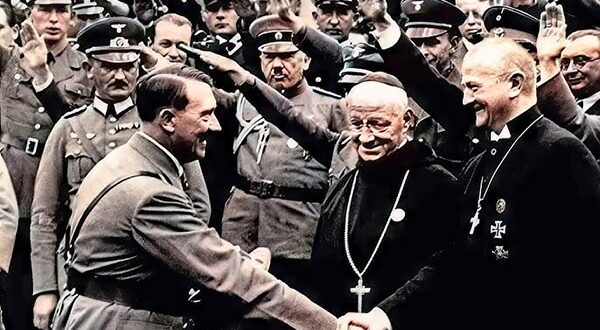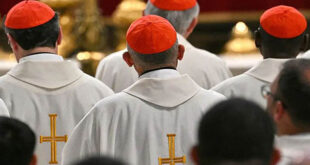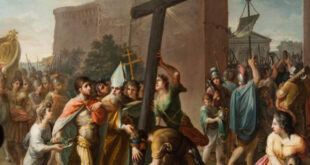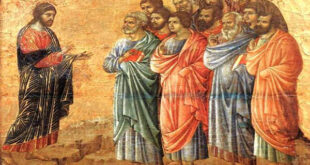In 20th-century history, few figures evoke as much moral condemnation as Adolf Hitler. His totalitarian regime and Nazi ideology led to World War II and the Holocaust, one of humanity’s greatest atrocities. However, some circles have spread the idea that the Catholic Church was complicit with Nazism or had an ambiguous relationship with Hitler. Is this true?
This article seeks to shed light on the relationship between the Catholic Church and Hitler’s regime, examining historical facts and the theological context that shaped its stance against Nazism.
1. Was Hitler Catholic?
Technically speaking, Adolf Hitler was baptized in the Catholic Church and grew up in a culturally Catholic environment in Austria. However, this does not make him a practicing Catholic or someone who followed Church doctrine. In fact, in his speeches and writings, Hitler displayed contempt for authentic Christianity and sought to promote a state religion centered on race and the State.
Despite his occasionally ambiguous rhetoric (especially in his early political years), Hitler considered Christianity a weakness. In private conversations, documented in the book Hitler’s Table Talk (edited by Martin Bormann), the dictator expressed his disdain for the Christian faith, calling it “subversive” and “weak.”
Nazi propaganda sometimes manipulated Christian symbols to gain support, but in reality, Nazi ideology was fundamentally anti-Christian.
2. The Catholic Church’s Stance Against Hitler
The Catholic Church, through Pope Pius XI and later Pope Pius XII, condemned Nazi ideology from its inception.
Pius XI and the Encyclical Mit Brennender Sorge (1937)
One of the most forceful condemnations of Nazism came from the encyclical Mit Brennender Sorge (“With Burning Concern”), published in 1937 by Pope Pius XI. It was written in German (instead of Latin, to reach the faithful directly) and denounced the incompatibility of National Socialism with the Christian faith.
In this encyclical, the Pope criticized the exaltation of the State above God and the persecution of the Church in Germany. The encyclical was read in all German parishes on Palm Sunday in 1937, infuriating Hitler and leading to an intensification of repression against the Church.
Cardinal von Galen: “The Lion of Münster”
In Germany, one of the most courageous opponents of the Nazi regime was Cardinal Clemens August von Galen, Bishop of Münster. In his homilies, he openly condemned Nazi ideology, particularly its eugenics policies and the murder of disabled individuals in the “Aktion T4” euthanasia program.
His bravery inspired many German Catholics to resist as much as possible, and although Hitler considered arresting him, he feared that this would cause a popular uprising.
3. What About Pope Pius XII?
One of the most common attacks against the Catholic Church is the accusation that Pope Pius XII did not do enough to stop the Holocaust. However, historical evidence shows that Pius XII helped save thousands of Jews, using secret diplomacy and ordering convents and monasteries to shelter refugees.
The Chief Rabbi of Rome at the time, Israel Zolli, was so impressed by Pius XII’s efforts that after the war, he converted to Catholicism and took the name Eugenio in honor of the Pope (Eugenio Pacelli was Pius XII’s birth name).
Many historians, including Jewish scholars like Pinchas Lapide, have documented that the Catholic Church under Pius XII contributed to the rescue of approximately 800,000 Jews.
4. Nazi Persecution Against the Catholic Church
Far from being an ally of Nazism, the Church was one of its main targets of persecution.
- Priests and religious figures in concentration camps: Around 2,579 Catholic clergy were sent to the Dachau concentration camp, where many perished.
- Destruction of Catholic organizations: From 1933 onward, the Nazis dissolved many Catholic associations and severely restricted religious freedom.
- Murder of Catholic leaders: Many priests and bishops who opposed the regime were arrested and executed.
Father Maximilian Kolbe, a Polish Franciscan priest, was a Catholic martyr who offered his life to save another prisoner in Auschwitz.
5. Theological Reflection
From a Catholic perspective, the Church’s opposition to Nazism was not merely political but deeply theological.
- Nazism as Idolatry of the State
- Nazi ideology placed the State and the Aryan race at the center of everything, violating the First Commandment: “You shall have no other gods before me” (Exodus 20:3).
- Rejection of Human Dignity
- The Church teaches that every human being is created in God’s image (Genesis 1:27). Nazi ideology denied this dignity to Jews, the disabled, and other minorities.
- The Christian Duty of Moral Resistance
- Despite the circumstances, many Christians resisted bravely. Figures like Edith Stein (Saint Teresa Benedicta of the Cross), a Jewish convert to Catholicism and Carmelite nun murdered at Auschwitz, demonstrate the Christian witness amid persecution.
Conclusion
The Catholic Church was not complicit with Nazism; rather, it was one of its primary opponents. From Pope Pius XI to thousands of priests, religious, and laypeople, the Catholic faith was a light in the darkness of Nazism.
Accusations of collusion between Hitler and the Church lack historical foundation and are often based on prejudice or misrepresentation of the facts.
As Catholics, we are called to know our history and defend the truth. The fight against evil and the defense of human dignity remain ongoing challenges. The bravery of those who resisted Nazism, guided by their faith, continues to inspire us today.
May the testimony of these martyrs and saints encourage us to live our faith with authenticity and courage.







I was never exposed to Catholic history as it related to the tie and fall of Nazi Germany. It has inspired me to find out more in light of today’s events.
There were Roman Catholic Priests who supported Hitler and his treatment of Jews – “Coughlin’s Antisemitic Views
During the 1920s, Coughlin’s antisemitic views were muted on the air. After his split with Roosevelt and with the rise of National Socialism and fascism in Europe, however, he attacked Jews explicitly in his broadcasts. Some historians attribute this change to Coughlin taking advantage of rising antisemitism around the world in order to keep himself relevant. Based on his speeches, writings, and associations, however, he appears to have had significant antisemitic sentiment throughout his career.
In the days and weeks after Kristallnacht, Coughlin defended the state-sponsored violence of the Nazi regime. He argued that Kristallnacht was justified as retaliation for Jewish persecution of Christians. He explained to his listeners on November 20, 1938, that the “communistic government of Russia,” “the Lenins and Trotskys…atheistic Jews and Gentiles,” had murdered more than 20 million Christians and had stolen “40 billion [dollars]…of Christian property.”
For years Coughlin publicly derided “international bankers,” a phrase that most of his listeners understood to mean Jewish bankers. Such antisemitic views were expressed on the pages of Social Justice. In a series of articles published in 1938, Coughlin lambasted “Jewish” financiers and their control over world politics. These articles culminated with a story recounting his own version of the infamous Protocols of the Elders of Zion. This antisemitic publication falsely purported to be minutes from meetings of Jewish leaders who were plotting to take over the world.” https://encyclopedia.ushmm.org/content/en/article/charles-e-coughlin
Thank you for your comment. I understand the concern you raise, because history is complex and, unfortunately, there are episodes where people linked to the Church have acted in ways contrary to the Gospel. However, it is very important to distinguish between the sins or personal errors of certain individuals and the authentic doctrine of the Catholic Church.
The case of Father Charles Coughlin, which you mention, is a very specific and sadly well-known one in the United States. Indeed, he used the radio in the 1930s and 1940s to spread speeches filled with antisemitism and sympathies toward totalitarian regimes. But several points must be made clear:
Coughlin did not represent the Church.
His personal opinions were never the official teaching of the Catholic Church. In fact, over time his publications were prohibited and his activity as a public preacher was restricted by his own ecclesiastical superiors.
The Church condemns antisemitism.
Long before Nazism, Pope Pius XI had already clearly declared: “Spiritually, we are all Semites” (1938). This statement was made precisely to condemn racial and religious hatred against the Jews.
There were priests and bishops who firmly opposed Hitler.
While a few were seduced or failed to react, thousands of priests and religious were persecuted, deported, and killed by the Nazis. Let us remember, for example, Saint Maximilian Kolbe, who died in Auschwitz offering his life for another prisoner, or the thousands of Polish and German priests who were martyred for refusing to submit to Nazi ideology.
The Church should not be judged by the sins of some.
Human history is full of light and shadow. The Church is holy because of her Founder and the sacraments, but she is made up of sinful men. What a particular priest may have said or done in his time does not invalidate the universal teaching of the Church, which is opposed to racism, violence, and all antisemitism.
In short, what we must be clear about is that antisemitism never has been and never will be part of Catholic doctrine. On the contrary, Catholicism recognizes in the Jewish people the roots of the Christian faith and condemns any attack against any person on the basis of race or religion.
I thank you for the opportunity to clarify this point. Cases such as Coughlin’s remind us that priests are men, with virtues and defects, and that for this very reason we must always return to the Gospel, where Christ teaches us to love even those who persecute us.
A cordial greeting in Christ